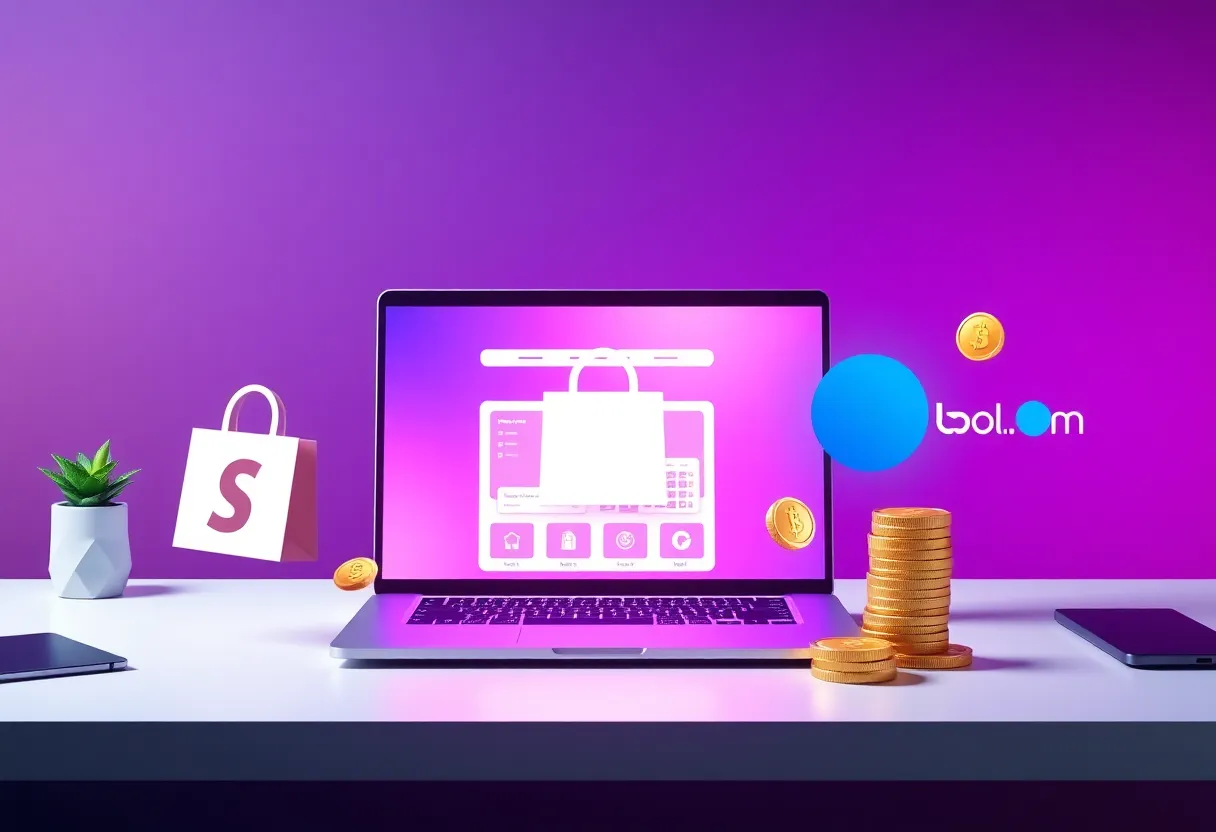Table of Contents
The E-commerce Landscape in the Netherlands
Dutch shoppers love buying online. In 2022, e-commerce sales in the Netherlands hit €30 billion, growing 13% from the previous year. This surge shows how much the Dutch embrace digital shopping.
At the heart of this booming market is Bol.com, often called the “Amazon of the Netherlands”. Let’s look at some key facts about Bol.com:
- Over 13 million active customers
- More than 50,000 connected sellers
- Offers 30 million products
- Holds about 40% market share in Dutch e-commerce
These numbers show why Bol.com is a big deal for sellers wanting to reach Dutch shoppers.
Now, let’s compare some features of Shopify and Bol.com:
| Feature | Shopify | Bol.com |
|---|---|---|
| Store customization | High | Limited |
| Built-in audience | No | Yes |
| Multichannel selling | Yes | No |
| Fees | Monthly + transaction | Commission-based |
Shopify gives you more control over your store’s look and feel. Bol.com, on the other hand, brings a ready-made audience but less flexibility.
For sellers looking to grow, combining Shopify’s powerful tools with Bol.com’s massive reach makes sense. That’s where integration apps come in handy. Our Marketplace Connect app helps bridge this gap, letting you manage both channels easily.
Check out this video to learn more about setting up Bol.com with Shopify:
Understanding how these platforms work together can help you tap into the growing Dutch e-commerce market. With the right tools, you can reach more customers and boost your sales without doubling your workload.
Setting Up Your Shopify-Bol.com Integration
Getting your Shopify store connected to Bol.com doesn’t have to be a headache. With the right tools, you can have your products listed on both platforms in no time. Let’s walk through the key steps:
- Get your API credentials from both Shopify and Bol.com
- Choose an integration tool like Marketplace Connect
- Link your accounts using the provided API keys
- Map your product categories between platforms
- Sync your inventory for the first time
Once you’ve completed these steps, you’re ready to start selling on both channels. But remember, the real magic happens when you keep your inventory and orders in sync automatically.
Product Listing Synchronization
Getting your products to show up correctly on Bol.com is crucial. You’ll want to make sure your titles, descriptions, and images are optimized for both platforms. Here’s a quick checklist:
- Use clear, descriptive titles
- Include key product features in the description
- Upload high-quality images that meet Bol.com’s requirements
- Set competitive prices that work for both marketplaces
By taking care of these details, you’ll increase your chances of success on Bol.com while keeping your Shopify store running smoothly.
Optimizing Inventory Management Across Platforms
Managing inventory across multiple sales channels can be tricky. The last thing you want is to oversell and disappoint customers. Here’s how to keep things running smoothly:
- Set up real-time stock updates between Shopify and Bol.com
- Use buffer stock to prevent overselling
- Regularly audit your inventory levels across platforms
Tools like Marketplace Connect can automate much of this process, saving you time and reducing errors. It’s worth looking into if you’re serious about multi-channel selling.
This video offers some great tips on selling on Bol.com, including inventory management strategies that can help you succeed on the platform.
Handling Stock Discrepancies
Even with the best systems, discrepancies can happen. Here’s a quick guide to resolving them:
- Regularly compare stock levels between platforms
- Investigate any differences promptly
- Adjust stock manually if needed
- Review your sync settings to prevent future issues
By staying on top of these tasks, you’ll keep your inventory accurate and your customers happy.
Streamlining Order Fulfillment and Customer Service
Efficient order processing is key to keeping customers satisfied across both Shopify and Bol.com. Here’s how to streamline your operations:
| Task | Shopify | Bol.com |
|---|---|---|
| Order Processing | Automatic | Synced with integration tool |
| Shipping Updates | Built-in | Requires manual input or integration |
| Customer Service | Direct through store | Through Bol.com platform |
By centralizing your order management, you can save time and reduce errors. Many sellers find that using a tool like Marketplace Connect helps them manage orders from multiple channels in one place.
Handling Returns and Customer Inquiries
Dealing with returns and customer questions can be challenging when selling on multiple platforms. Here’s how to handle it smoothly:
- Set up clear return policies for both Shopify and Bol.com
- Use a centralized customer service tool to track inquiries
- Train your team on the specifics of each platform
- Monitor customer feedback to improve your processes
Remember, good customer service can turn a one-time buyer into a loyal customer, no matter which platform they use to purchase from you.
By focusing on these key areas – integration, inventory management, and customer service – you can create a seamless experience for your customers across both Shopify and Bol.com. It takes some effort to set up, but the potential for increased sales and customer satisfaction makes it worthwhile.
Measuring Success and Overcoming Challenges
Integrating Shopify with Bol.com opens up new opportunities, but success doesn’t happen automatically. Smart sellers track key metrics to gauge their multi-channel performance:
- Sales growth across platforms
- Order fulfillment speed
- Customer satisfaction ratings
- Inventory turnover rate
- Profit margins by channel
Monitoring these KPIs helps identify what’s working and where improvements are needed. But integration isn’t always smooth sailing. Common pitfalls include:
- Inventory sync errors
- Pricing inconsistencies
- Order processing delays
- Customer service gaps
Fortunately, most issues have straightforward fixes. Using a tool like Marketplace Connect can automate syncing and reduce manual errors. Regular audits of your integration setup also help catch problems early.
| Challenge | Solution |
|---|---|
| Inventory discrepancies | Use real-time sync tools |
| Pricing errors | Set up automated price rules |
| Slow order processing | Streamline fulfillment workflows |
Real-world success stories show the potential of Shopify-Bol.com integration. One Dutch home goods seller saw a 40% sales boost after expanding to Bol.com through Shopify. They credit automated inventory management for allowing them to scale without hiring extra staff.
Another case study comes from a vintage clothing shop. By syncing their Shopify store with Bol.com, they tapped into a new customer base passionate about retro fashion. Their cross-border sales grew 25% in just three months.
The key takeaway? With the right approach and tools, Shopify sellers can unlock significant growth through Bol.com integration. It takes some setup work, but the payoff in expanded reach and sales can be substantial.
Wrap-up
Integrating Shopify with Bol.com opens up a world of possibilities for e-commerce businesses. By connecting these platforms, you can tap into new markets, streamline operations, and boost sales without the headache of managing multiple systems.
As online shopping continues to grow, having a presence on diverse marketplaces is becoming crucial. Tools like Marketplace Connect make this process smoother, handling the nitty-gritty of order syncing and inventory updates automatically.
Remember, success in e-commerce isn’t just about being everywhere – it’s about managing your presence efficiently. Whether you’re just starting out or looking to expand, consider how integrating Shopify with Bol.com could fit into your business strategy. The right tools can make all the difference in turning multi-channel selling from a challenge into an opportunity for growth.
Ready to learn more? Check out our FAQ section below for answers to common questions about Shopify and Bol.com integration.
Common Questions About Shopify-Bol.com Integration
How much does it cost to integrate Shopify with Bol.com?
The cost of integrating Shopify with Bol.com varies depending on the solution you choose. Some apps, like Marketplace Connect, start at $19.99 per month and offer a free trial. It’s important to compare features and pricing to find the best fit for your business needs and budget.
Can I integrate other marketplaces along with Bol.com?
Yes, many integration tools support multiple marketplaces. For example, Marketplace Connect allows you to connect Shopify with Bol.com, Amazon, Etsy, and more. This multi-channel approach can help expand your reach and streamline operations across different platforms.
What kind of support is available for troubleshooting?
Most integration apps offer customer support through various channels such as email, chat, or documentation. Marketplace Connect, for instance, provides detailed guides and responsive customer service to help you resolve any issues quickly. It’s always a good idea to check the support options before choosing an integration solution.
How does inventory syncing work between Shopify and Bol.com?
Inventory syncing is typically automated with integration tools. They update stock levels in real-time across both platforms to prevent overselling. When an item sells on either Shopify or Bol.com, the inventory is adjusted automatically on both channels, keeping your stock accurate and up-to-date.
Will integrating Bol.com affect my Shopify store’s performance?
A well-designed integration should not negatively impact your Shopify store’s performance. In fact, it should enhance your overall e-commerce operations. Tools like Marketplace Connect are built to work efficiently with Shopify, ensuring smooth performance while managing multiple sales channels.
How long does it take to set up the integration?
The setup time can vary, but many integration apps aim for a quick and straightforward process. With Marketplace Connect, for example, you can often get started within minutes. The exact time depends on factors like the number of products you’re syncing and any customizations you need. Most solutions offer step-by-step guides to help you through the setup process.





